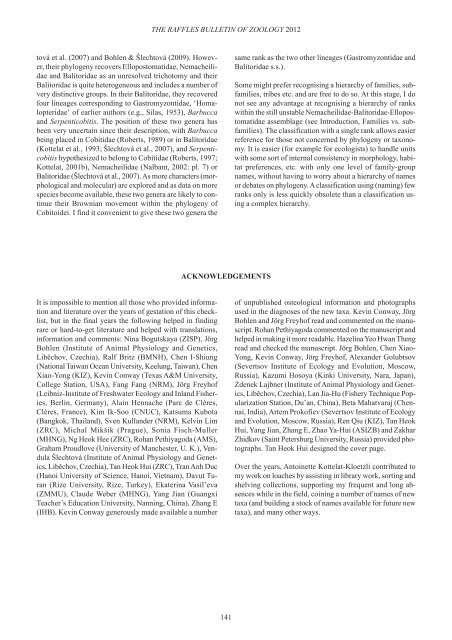Conspectus cobitidum - Raffles Museum of Biodiversity Research
Conspectus cobitidum - Raffles Museum of Biodiversity Research
Conspectus cobitidum - Raffles Museum of Biodiversity Research
Create successful ePaper yourself
Turn your PDF publications into a flip-book with our unique Google optimized e-Paper software.
tová et al. (2007) and Bohlen & Šlechtová (2009). However,<br />
their phylogeny recovers Ellopostomatidae, Nemacheilidae<br />
and Balitoridae as an unresolved trichotomy and their<br />
Balitoridae is quite heterogeneous and includes a number <strong>of</strong><br />
very distinctive groups. In their Balitoridae, they recovered<br />
four lineages corresponding to Gastromyzontidae, ‘Homalopteridae’<br />
<strong>of</strong> earlier authors (e.g., Silas, 1953), Barbucca<br />
and Serpenticobitis. The position <strong>of</strong> these two genera has<br />
been very uncertain since their description, with Barbucca<br />
being placed in Cobitidae (Roberts, 1989) or in Balitoridae<br />
(Kottelat et al., 1993; Šlechtová et al., 2007), and Serpenticobitis<br />
hypothesized to belong to Cobitidae (Roberts, 1997;<br />
Kottelat, 2001b), Nemacheilidae (Nalbant, 2002: pl. 7) or<br />
Balitoridae (Šlechtová et al., 2007). As more characters (morphological<br />
and molecular) are explored and as data on more<br />
species become available, these two genera are likely to continue<br />
their Brownian movement within the phylogeny <strong>of</strong><br />
Cobitoidei. I find it convenient to give these two genera the<br />
It is impossible to mention all those who provided information<br />
and literature over the years <strong>of</strong> gestation <strong>of</strong> this checklist,<br />
but in the final years the following helped in finding<br />
rare or hard-to-get literature and helped with translations,<br />
information and comments: Nina Bogutskaya (ZISP), Jörg<br />
Bohlen (Institute <strong>of</strong> Animal Physiology and Genetics,<br />
Liběchov, Czechia), Ralf Britz (BMNH), Chen I-Shiung<br />
(National Taiwan Ocean University, Keelung, Taiwan), Chen<br />
Xiao-Yong (KIZ), Kevin Conway (Texas A&M University,<br />
College Station, USA), Fang Fang (NRM), Jörg Freyh<strong>of</strong><br />
(Leibniz-Institute <strong>of</strong> Freshwater Ecology and Inland Fisheries,<br />
Berlin, Germany), Alain Hennache (Parc de Clères,<br />
Clères, France), Kim Ik-Soo (CNUC), Katsuma Kubota<br />
(Bangkok, Thailand), Sven Kullander (NRM), Kelvin Lim<br />
(ZRC), Michal Mikšik (Prague), Sonia Fisch-Muller<br />
(MHNG), Ng Heok Hee (ZRC), Rohan Pethiyagoda (AMS),<br />
Graham Proudlove (University <strong>of</strong> Manchester, U. K.), Vendula<br />
Šlechtová (Institute <strong>of</strong> Animal Physiology and Genetics,<br />
Liběchov, Czechia), Tan Heok Hui (ZRC), Tran Anh Duc<br />
(Hanoi University <strong>of</strong> Science, Hanoi, Vietnam), Davut Turan<br />
(Rize University, Rize, Turkey), Ekaterina Vasil’eva<br />
(ZMMU), Claude Weber (MHNG), Yang Jian (Guangxi<br />
Teacher’s Education University, Nanning, China), Zhang E<br />
(IHB). Kevin Conway generously made available a number<br />
THE RAFFLES BULLETIN OF ZOOLOGY 2012<br />
ACKNOWLEDGEMENTS<br />
141<br />
same rank as the two other lineages (Gastromyzontidae and<br />
Balitoridae s.s.).<br />
Some might prefer recognising a hierarchy <strong>of</strong> families, subfamilies,<br />
tribes etc. and are free to do so. At this stage, I do<br />
not see any advantage at recognising a hierarchy <strong>of</strong> ranks<br />
within the still unstable Nemacheilidae-Balitoridae-Ellopostomatidae<br />
assemblage (see Introduction, Families vs. subfamilies).<br />
The classification with a single rank allows easier<br />
reference for those not concerned by phylogeny or taxonomy.<br />
It is easier (for example for ecologists) to handle units<br />
with some sort <strong>of</strong> internal consistency in morphology, habitat<br />
preferences, etc. with only one level <strong>of</strong> family-group<br />
names, without having to worry about a hierarchy <strong>of</strong> names<br />
or debates on phylogeny. A classification using (naming) few<br />
ranks only is less quickly obsolete than a classification using<br />
a complex hierarchy.<br />
<strong>of</strong> unpublished osteological information and photographs<br />
used in the diagnoses <strong>of</strong> the new taxa. Kevin Conway, Jörg<br />
Bohlen and Jörg Freyh<strong>of</strong> read and commented on the manuscript.<br />
Rohan Pethiyagoda commented on the manuscript and<br />
helped in making it more readable. Hazelina Yeo Hwan Theng<br />
read and checked the manuscript. Jörg Bohlen, Chen Xiao-<br />
Yong, Kevin Conway, Jörg Freyh<strong>of</strong>, Alexander Golubtsov<br />
(Severtsov Institute <strong>of</strong> Ecology and Evolution, Moscow,<br />
Russia), Kazumi Hosoya (Kinki University, Nara, Japan),<br />
Zdenek Lajbner (Institute <strong>of</strong> Animal Physiology and Genetics,<br />
Liběchov, Czechia), Lan Jia-Hu (Fishery Technique Popularization<br />
Station, Du’an, China), Beta Mahatvaraj (Chennai,<br />
India), Artem Prok<strong>of</strong>iev (Severtsov Institute <strong>of</strong> Ecology<br />
and Evolution, Moscow, Russia), Ren Qiu (KIZ), Tan Heok<br />
Hui, Yang Jian, Zhang E, Zhao Ya-Hui (ASIZB) and Zakhar<br />
Zhidkov (Saint Petersburg University, Russia) provided photographs.<br />
Tan Heok Hui designed the cover page.<br />
Over the years, Antoinette Kottelat-Kloetzli contributed to<br />
my work on loaches by assisting in library work, sorting and<br />
shelving collections, supporting my frequent and long absences<br />
while in the field, coining a number <strong>of</strong> names <strong>of</strong> new<br />
taxa (and building a stock <strong>of</strong> names available for future new<br />
taxa), and many other ways.

















